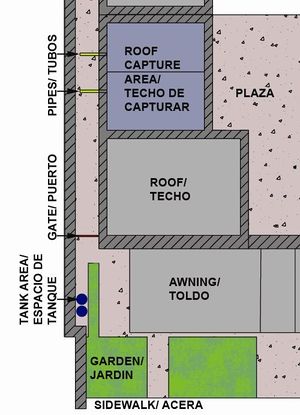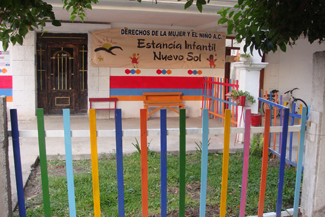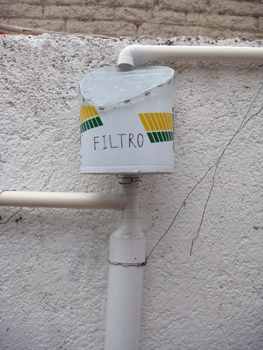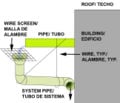

El Nuevo Sol is a daycare facility located at 30 Cinco de Mayo for children from 2 months old to 10 years old. It is owned and directed by Sra. Garcia Dominguez and mainly serves working mothers. She is interested in a rainwater catchment system to serve her organic garden (an additional Parras 2008 project) and to teach the children and parents about water collection techniques and eventually water purification techniques.
Our goal is to create an easy to use and maintain rainwater collection system to provide an alternative to municipal water for the organic garden. The city of Parras has a rich history with water and is known as an oasis in the desert.
Nosotros (Linsey y Claire) queremos presentarles nuestro proyecto-un sistema para la captación de agua de lluvia. Esta ubicada en 30 Cinco de Mayo, en la guardaría El Nuevo Sol.
La ciudad de Parras tiene una historia formada por el agua. Los posos, norias, manantiales y fuques que dan agua para la cultivación, la ganadería y para cocinar, tomar, y limpiar en la casa. El subsuelo en los cerros de Parras han estado ricos en este tesoro natural, pero en estos días el consumo de agua esta creciendo, mientras que los cerros son deforestados y no pueden absorber tanto lluvia como en edades pasados.
Las ventajas de un sistema para capturar el agua de lluvia son muchos. Es una manera de conservar el agua del subsuelo, y también puede aliviar la presión que existe en el sistema municipal de la distribución de agua, lo cual no es suficiente para todas las casas en la ciudad. Atrapar la escorrentía pluvial de los techos puede minimizar la inundación de los calles. En vez de estar una molestia, esta agua se puede guardar por uso en tiempos secos.
Este verano nuestro grupo de Humboldt State conoció a Sra. Sofía García Domininguez, la directora del Nuevo Sol, una guardaría que apoya a madres jóvenes. Ella quería que la ayudemos con unas ideas que tenia para mejorar las vidas de las mujeres y niños con que trabaja. Hablemos con ella y con el dueño de la propiedad, Sr. Juan Jaime, y resuelta que hay dos proyectos que hacemos con el Nuevo Sol- una huerta orgánico para enseñar la cultivación de verduras, y una sistema de captación de agua pluvial para irrigar la huerta. Estamos trabajando en colaboración con estos dos socios de la comunidad, para asegurar que estos proyectos de tecnología sustentable sean útiles y beneficial para los a quienes son intentados.
Advantages of Harvesting Rainwater[1]
- Provides very high-quality water (in most areas), soft and low in minerals, so less soap is required
- Reduces mineral deposits on fixtures, pipes, and water heaters
- Offsets the need for pumping groundwater; reduces energy needed for deep well pumping and water softening
- Conserves irrigation water because plants often repsond better to rainwater than groundwater, increasing yield
- Reduces erosion and flooding typically created by runoff
- Reduces silting and contamination of waterways from runoff
Components of a Rooftop Rainwater Harvesting System[2]
- Catchment Area
- Gutters and Downspouts
- Storage Tanks/Cysterns
Objectives/Objetivos[edit | edit source]

Overall vision: To retrofit the existing building with gutters and drains and then attach the drains to a water catchment system. This system will provide water for the organic garden that will be located in the front yard of the building or any other irrigation purpose. It shall be fully functional (e.g. capture and store rainwater from the roof, not leak or have components break, and reduce city water usage) by the end of four weeks. The gutter and drain system shall blend in with the existing architecture. The water holding tank shall be hidden off to the side and visually unobtrusive. All components shall be able to withstand the most severe weather conditions (e.g. strong winds, torrential rains, falling branches, etc.).
The three goals for this project are:
- The first is to capture and retain rainwater to provide water for the organic garden at el Nuevo Sol that has been started by our fellow program members. We don't want this garden to add a strain onto the existing municipal water system.
- Our second objective is to provide an educational opportunity for expressing the importance of water conservation. When the project is finished, together with the garden team, we will host an outdoor party at the day care center. During this event we will explain to the children how the rainwater catchment sytem fuctions and how it was constructed. In greater detail we will demonstrate how the system works and describe any maintenance needs to Mrs. Sofía and to Mr. Juan Jaime.
- The third goal we have is to create a prototype for future water catchment system designs in Parras. This system will be easily seen by any patrons of el Nuevo Sol and we hope that this visibility will inspire them to create their own water catchment systems at their homes. We want to construct the system in a manner that is simple and easy to reproduce.
Los propósitos que tenemos por este proyecto son tres:
- El primero es capturar y guardar agua de lluvia para la huerta que hacen nuestras compañeras en el Nuevo Sol. No queremos que este huerta añada a la carga que tiene el sistema municipal.
- Nuestro segundo objetivo es proveer una oportunidad educativa para enseñar sobre la necesidad de conservar el agua. Cuando está terminado, junto con el equipo de la huerta, tendremos una fiesta de abertura en la guardaría. Hablamos con los niños de cómo funciona el sistema y para que lo construyamos. Mostraremos el sistema a Sra. Sofía y a Sr. Juan Jaime, y explicaremos como mantenerlo.
- El tercer propósito que tenemos es proporcionar un prototipo para otros sistemas para capturar el agua de lluvia en Parras. Este sistema va a ser muy visible a la gente que viene a El Nuevo Sol, y la esperanza es que muchos se inspirarán para crear uno para sus propias casas. Queremos construirlo en una manera que sea simple y fácil reproducir.
Criteria[edit | edit source]
| Criteria | Weight (0-10 highest) |
|---|---|
| Económicamente viable para implementar y mantener | 7 |
| La comunidad necesita, quiere, y participa en el proyecto | 8 |
| Nos queda adentro nuestro presupuesto | 10 |
| Apoyar la ecología | 10 |
| Seguridad del sistema y los materiales | 9 |
| Utilizar recursos locales | 8 |
| Durabilidad | 6 |
| Adaptabilidad y eliminar complexiones que no son necesario | 7 |
| Esteticas | 8 |
Budget/Presupuesto[edit | edit source]
| Materiales | Unit Price (Pesos) | Quantity | Cost |
|---|---|---|---|
| Codos PVC 2" >90 | $3 | 10 | $30 |
| Tubos PVC 2" (6 meters) | $51 | 3 | $153 |
| PVC 2" Elbow >45/Codos PVC 2" >45 | $7 | 4 | $14 |
| PVC 2" Coupler/Coples PVC 2" | $5 | 2 | $10 |
| Nail 6"/Clavo 6" | $0.33 | 6 | $2 |
| Plastic and Fiberglass Water Tank/Tinaco (400 litros) | $250 | 1 | $250 |
| Segueta | $11 | 1 | $11 |
| Metro Manguera 3/4 | $9 | 1 | $9 |
| Tela Masquitera (cm) | $0.30/cm | 20cm | $6 |
| Nozzle/Flaves Nariz | $30 | 2 | $60 |
| Conector Manguera 3/4 | $12 | 1 | $12 |
| Empaquitos | $1 | 2 | $2 |
| PVC Glue/Pegamento PVC 1/8 | $20.50 | 1 | $20.50 |
| 4" to 2" PVC Converter/Red PVC 4 a 2 | $8 | 2 | $16 |
| PVC 2" Tee Branch/Tee PVC 2" | $5 | 2 | $10 |
| Total | $620.50 |
Calculations/Cálculos[edit | edit source]
There are four collection areas of the roof that are available to provide water for our system. However, after making a few calculations we determined that we would only need to use two of them to total an area of 22.9 meters square (please see fig.1). We are only using a portion of the total roof, because this area provides us with a suffcient amount of water for the garden. The awning portion of the roof was taken out as an option, because it would have required extensive changes to the frontage of the building, extra labor and materials and may have created drainage difficulties. If more water is needed in the future, it would be possible to use this portion of the roof. On average our collection area will provide 40 liters of water in July (the rainiest month) and 6.1 liters of water in February (the driest month).
If the garden is completely planted during times of the year when there is no rain, the garden will need 137 liters of water per day. Our tank will have a capacity of 400 liters and in this case will need to be supplemented by the municipal water supply until the rains recharge the system. We are limited to one tank because of space and budget. A second or third tank could be added to the system by placing the additional tanks on stands next to the existing one and connecting them to one another with sealed piping.
Daily Garden Water Needs Calculations[edit | edit source]
Approximate area of garden = 9m2.
- We assumed 16 plants per meter squared and 1 gal per 3 days for 1 tomato plant. 3.8 liters = 1 gal, which when divided by 3 is a little more than 1 liter per plant per day with no additional rain.
- 16 plants per m2 x 9m2 = 144 plants.
- 144 plants = 144 liters per day.
- Real number of plants in garden and 4 planters = 60 plants.
- 60 plants = 60 liters per day.
Roof Yearly Average Rain Collection[edit | edit source]
- Total Roof Area = 22.9m2.
- Runoff Coefficient = 0.75 (because the roof is flat and made of concrete).
- Average Annual Rainfall for Parras = 366.36mm.
- 22.9m2 x 366.36mm x 0.75 = 6045 liters per year.
- 6045 liters per year/365 days = 16.6 liters per day.
Roof July Average Rain Collection[edit | edit source]
- Total Roof Area = 22.9m2.
- Runoff Coefficient = 0.75 (because the roof is flat and made of concrete).
- Average July Rainfall for Parras = 72.3mm.
- 22.9m2 x 72.3mm x 0.75 = 1242 liters per year.
- 6045 liters for July/31 days = 40.0 liters per day.
Roof February Average Rain Collection[edit | edit source]
- Total Roof Area = 22.9m2.
- Runoff Coefficient = 0.75 (because the roof is flat and made of concrete).
- Average February Rainfall for Parras = 10.0mm.
- 22.9m2 x 10.0mm x 0.75 = 172 liters per year.
- 1193 liters for February/28 days = 6.1 liters per day.
Pipe Capacity Calculations[edit | edit source]
Rule of thumb: 1cm2 of gutter cross section per 1m2 of roof area.[3]
- 2" PVC pipe cross section area: 2"=Xcm, 2" x (2.54cm/1in)=5.08cm. Radius = 2.54cm
- (2.54cm)2 x pi(3.14)=20.3cm2. Cross section area=20.3cm2.
- Our ratio then is 20.3cm2 to 22.9m2, which fits the recommended ratio.
El área del techo es 22.9 metros cuadrados. Solo vamos a utilizar la parte trasera del techo, porque nos va a colectar agua suficiente por la necesidad de la huerta. La parte delantera del techo es mas complicado y requiere unos cambios antes de que se pueda usarlo, pero si se puede utilizarlo si fuera necesario. El agua del techo donde colectaremos tiene un promedio de 40 litros por día en julio, y 6.1 litros por día en febrero.
Si toda la huerta sea cultivado durante los tiempos secos, puede usar hasta 137 litros por día. En este caso, puesto que nuestros un tanque va a tener un volumen de 400 litros, será necesario usar agua municipal en conjunción con el agua de lluvia. Estamos limitadas a un tanque por el tiempo que tenemos para terminar y por nuestro pequeño presupuesto. Si el dueño Sr. Juan Jaime, o la directora Sra. Sofía quieren guardar mas agua, se pueden añadir mas barrilles muy fácilmente.
Materials/Materiales[edit | edit source]
-
2" PVC tube and tube connectors. Includes a 45°, 90° and T-branch.
-
Drill, cement drill bit, PVC cement, 6" nail, silicone glue, hammer, pliers and wire cutter, tape measure, faucet and gloves.
-
Materials for the first flush system. The ball floats to the top to close the system, the Velcro keeps the bottom lid on, the glue adheres the Velcro to the plastic and there's the 4" PVC lid.
Designs[edit | edit source]
-
Fig. 2 Elevation view of Nuevo Sol water intake pipe
-
Fig. 3 Elevation view of Nuevo Sol pipe layout
There are three basic components of this system-the rainwater catchers which catch the water which drains from the roof, the pipes that carry the water, and the storage area which includes a screen filter, a first flush sediment trap, a water tank and a runoff pipe. We worked with several designs, looking for maximum simplicity, safety and efficiency.
The Catchers[edit | edit source]
Our first design concept is shown in figures 2 and 3. We did not want to connect pipes directly to the outlet pipes off the roof in case the pipes got clogged or something backed up the system and water would be left to fill the roof. At all costs we did not want to compromise the structural integrity of the roof. For this reason we also did not place screens on the outlets from the roof.
We used 4" to 2" PVC reducers for the collectors in the first model. When we tested it with a 5 gallon bucketfull of water, it worked well at first with a slow flow of water. When we simulated a very heavy downpour with dumping the bucket all at once, we lost about 40% of the flow.
The second design had cones made of flexible 4" PVC inserted into the collectors to increase the collection area. We also covered the openings with a fine mesh to keep out flakes of paint and cement. When we tested this the catchers worked well but the mesh didn't self clean as we had hoped and caused water to run off insead of passing through.
The third and final design for the catchers was simply the cones inserted into the 4" reducers. We solved the mesh screening problem by putting in a self-cleaning screen further down by the tank.
The Tubes[edit | edit source]
We decided on 2" PVC for economic reasons. Costing 51 pesos per 6 meters, it was a considerable savings compared to 88 pesos for the 3" and 125 for the 4" pipe. (Note: El Roble, the hardware store on Cinco de Mayo, no longer carries 2" pipe in the thin size, which is what the above quote is for. The alternative thick pipe is 80 pesos for 6 meters.)
After the fact we double checked with math to assure that the pipe size would be adequate for the expected volume of water. Using a rule of thumb, 1 cm2 to every 100m2, as well as calculations based on flow rate and pipe friction, we determined that 2" pipe was an appropriate size. Click here to see the calculations.
Gutters need to be sloped at least 1/16 inch per foot of run.[4] They should be suspended from hangers no more than three feet apart.[5]
The Screen[edit | edit source]
This filter is made of a five gallon bucket cut to a 60% slope,[6] covered with a fine wire mesh, with a drain in the bottom. The water pours down through the screen and empties towards the first flush.
When we tested the design we noticed that a considerable amount of debris collected on the screen, and a small but steady stream of water drained away from the bucket following the screen over the edge. To correct these problems we cut the bucket to eliminate a flat spot in the slope, pulled the screen tighter, and applied silicon to the bottom lip. We also drilled a small hole in the bottom to drain out any water that is left after a rain.

The First Flush Sediment Trap[edit | edit source]
Our original design was a 5 gallon bucket, but before this made it off the drawing board we settled in favor of using a length of 4" pipe.
"One rule of thumb for first-flush diversion is to divert a minimum of 10 gallons for every 1,000 square feet of collection surface. However, first-flush volumes vary with the amount of dust on the roof surface, which is a function of the number of dry days, the amount and type of debris, tree overhang, and season." Exerpt from the Texas Manual on Rainwater Harvesting, 2005, pg 8.
For Our System:
1 gal = 100 ft2, 3.79 litres = 1 gal
22 m2 = 237 ft2
237 ft2 * (1 gal/100 ft2) = 2.37 gal
2.37 gal * (3.79 litres/1 gal) = 9 litres
We need a 9 litre first flush container.
Our 2" PVC pipe has a cross sectional area of 20.3 cm2 or 0.00203 m2
Pipe length needed: 0.00203 m2 * Xm = 0.009 m3
The Tank[edit | edit source]
For our water storage tank we used a tinaco from the local fabrica that is located on the left if you are driving down 16 de Septiembre away from Parras. They have seconds available for a reduced price, which are fully functional tanks with superficial defects that make it so they can't be sold for full price. We bought a 400 liter tank for $250 pesos. These tanks are wonderful, because they already have holes drilled into them and are ready for faucets to be added and obviously because they are specifically made for water.
The Runoff Pipes[edit | edit source]
The runoff pipes are used to divert the excess water once the tank is full. The water is directed out towards the street and the street drain using both a closed 2" PVC pipe and a 4" PVC pipe cut in half lengthwise. The 4" PVC pipe was used, because it was left over material and allowed for the extension that we needed to get the water from the 2" pipe to the street. An improvement to this portion of the system would be to secure both pipes to the wall they run next to.
Final Results[edit | edit source]
-
Intake water catchment points.
-
Filter and First Flush sediment trap.
-
Adobe stand with concrete finish on top to reduce erosion.
-
Tank on stand connected to system.
-
Water overflow outlet directing extra water toward street drain.
Suggestions[edit | edit source]
- Do NOT glue anything until you are absolutely positive that your design will work. We recommend testing the system with water and also having a third or fourth person review the system to ensure nothing is missed. Making changes after the piping has been glued minimizes options, costs additional money and takes time.
- Do NOT use tambos from the fabrica unless you are positive that the former contents were non-toxic.
- Use Hydraulic piping instead of sanitary piping even though it is more expensive. The fittings are more varied and appropriate for the system. This would have saved us a significant amount of time and we could have used less glue.
- To ensure that all the water is collected from the roof make the intake pipe catchment area larger in diameter than the pipe coming from the roof. This will make it easier to grab all of the water in a strong storm with a higher flow rate and volume.
- We had issues with our glue not adhering properly. More research needs to be done in this area for what materials are available in Parras. Our connections into and out of the tinaco and the filter had the most issues with the glue. Eventually we found a putty that worked at pipe joints and was waterproof. This was used to seal the hole around the tank intake point and the existing hole in the tank that we didn't use. Make sure to buy a significant amount of silicone.
- The next step for the rainwater catchment system could be to add a water purification system to create potable water.
- Locate a family or community that is not connected to the Parras municipal water supply.
Related Sites[edit | edit source]
- Rainwater Harvesting
- The Greywater Guerrillas
- The Texas Manual on Rainwater Harvesting
- DTU Rainwater Harvesting
- First Flush Phenomenon
- SafeRain
References[edit | edit source]
- ↑ Field Guide to Appropriate Technology (ed. Barret Hazeltine and Christopher Bull), Rainwater Collection, page 745
- ↑ Field Guide to Appropriate Technology (ed. Barret Hazeltine and Christopher Bull), Rainwater Collection, page 745
- ↑ Rainwater Catchment for Domestic Supply. Gould, John and Niessen-Petersen, Erik. ITDG Publishing 2003. Page 75.
- ↑ Rainwater Harvesting Systems for Montana. Rupp, Gretchen and Ben Cichowski. Montguide, Montana State University Extension. MT 199707 AG revised 11/06. Pg C-1.
- ↑ Rainwater Harvesting Systems for Montana. Rupp, Gretchen and Ben Cichowski. Montguide, Montana State University Extension. MT 199707 AG revised 11/06. Pg C-1.
- ↑ Rainwater Catchment Systems for Domestic Supply. Gould, John and Niessen-Petersen, Erik. ITDG Publishing 2003. Page 79.









